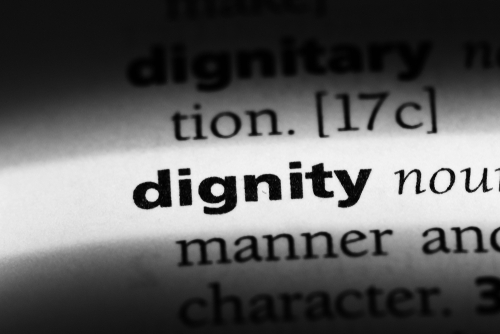The Collins dictionary defines dignity as “the sense that you have of your own importance and value, and other people’s respect for you.”
In 1964 The Human Rights Act outlawed discrimination based on race, colour, sex or national origin. This landmark legislation was aimed at protecting the rights and dignity of all citizens.
In 1990 the US government passed The Americans with Disabilities Act ensuring that its disabled citizens had the same rights of access to services and facilities as more able-bodied, protecting dignity regardless of ability or other demographic.
The Care Act (United Kingdom), passed in 2014 talks about an individual’s well-being stating that dignity/treating a person with respect is pivotal to all health and social care intervention.
In no clinical area is this more important than moving and handling as we are often helping people in the most private and personal of circumstances. The basis of any moving and handling plan is the risk assessment. However, most risk assessment templates follow a TILE (Task Individual Load Environment) template. The load in this instance refers to the person being moved and only considers weight size etc. In moving and handling we need to temper our risks assessments by ensuring they remain holistic and client-centered therefore maintaining respect and dignity.
Risk assessment, holism and dignity
As previously eluded to risk assessments provide a straightforward function that is to identify risk (MHOR 1992). The US equivalent OSH Act (1970) aims to ensure safe working conditions for men and women, which includes Hazardous identification and risk assessment.
However, if we use an Occupational Therapy theoretical approach, we can ensure that assessments remain holistic with the person being handled seen as more than just their weight, height and ability to assist within any given procedure.
Law Et al (1996) published a model of Occupational Therapy called the Person, Environment Occupation model (PEO). Key to this is that it sees the person as more than their height, weight and comorbidities. This model sees the person as someone who has beliefs, passions, motivations wishes, interests. A person that can feel stress, failure, distraction, pleasure, and satisfaction.
It is how the Person interacts with the environment that determines how they manage their occupations, such as self-care, productivity and leisure. As healthcare professionals we exist in the person’s environment, therefore how we interact with them can also affect their occupational performance. Full consideration of the person in a moving and handling assessment leads to a more holistic approach.
Understanding the client’s views and that of others in their environment such as loved ones, or carers can help produce a more well-rounded assessment, protecting that person’s dignity, beliefs, and values.
Training and dignity
Poor moving and handling practice leads to a person’s dignity being adversely affected.
Poor handling technique and carers without adequate training can lead to people being handled incorrectly, without due considerations for their wishes or full observation/understanding of handling plans. Regular high quality moving, and handling training can mitigate against that by ensuring that care staff and professionals have the skills and understanding to undertake the moving and handling operations that are required with that person. This training should encompass an understanding of the state’s legislative requirements in relation to what responsibilities people such as carers and health professionals have, as well as handling techniques, good practice and appropriate use of equipment.
Often care providers and even professional teams struggle to determine their training needs when compiling a training needs analysis. A professional training service would be able to provide assessment and guidance on training needs.
Dignity and equipment
In the last 10 years moving and handling equipment, technology has made significant developments. Improvements in ceiling track hoists, bed maneuverability equipment and equipment to help a fallen person from the floor, such as the Mangar Elk or Camel, all contribute to being able to reduce the number of carers required to assist whilst improving safety and outcomes for all. In some cases, a single carer can now be employed rather than two meaning that family members rather than external care providers can be more actively involved providing that’s the wish of the person with their dignity and safety being maintained.
Maintenance of equipment is also important, it must be kept in good working order, in line with The Occupational Health and Safety Administration (OSHA) regulations in the US and LOLER (1992) regulations in the UK.
Conclusion
Dignity is about respect, understanding the wishes of your client and often others in their environment such as loved ones and carers (formal and informal). We can achieve this by carrying out holistic risk assessments which can be aided by the use of a model such as PEO that sees a person as more than just a load. Legislation such as US Human rights and labor laws or the UK’s Care ACT reinforces the need to observe and maintain a person’s dignity.
Now more than ever equipment technology allows us to improve the options to handle people more comfortably, safely and with dignity.
Often being able to reduce the number of carers required to turn someone in bed for example when supporting personal care activities or helping a someone who has fallen off the floor with minimal drama/ embarrassment in an appropriate timescale within a residential or domestic care setting makes the difference between dignified or undignified intervention.
Maintaining a person’s dignity should always be at the heart of what we do as professionals within every area of clinical practice.
References
The Americans with Disabilities Act (1990) https://www.ada.gov/ada_intro.htm
Civil Rights Act (1964) http://www.archives.gov
Collins dictionary online “Definition of dignity” https://www.collinsdictionary.com/dictionary/english/dignity
Law, M Cooper B, Strong S, Stewart D, Rigby P & Letts L. (1996) The Person-Environment-Occupation Model: A Transactive approach to occupational Performance. Canadian Journal of Occupational Therapy. 63 (1): 9-23
LOLER regulations (1998) http://www.hse.gov.uk/pUbns/priced/loler.pdf
Moving and Handling Operating Regulations 1992 (as amended) (MHOR) http://www.hse.gov.uk/foi/internalops/ocs/300-399/313_5.htm
Occupational Safety and Health Act (1970) http://www.osha.gov
The Care Act (2014) “promoting individual well-being” http://www.legislation.gov.uk/ukpga/2014/23/section/1/enacted
The Human Rights Act (1998) https://www.legislation.gov.uk/ukpga/1998/42/contents




